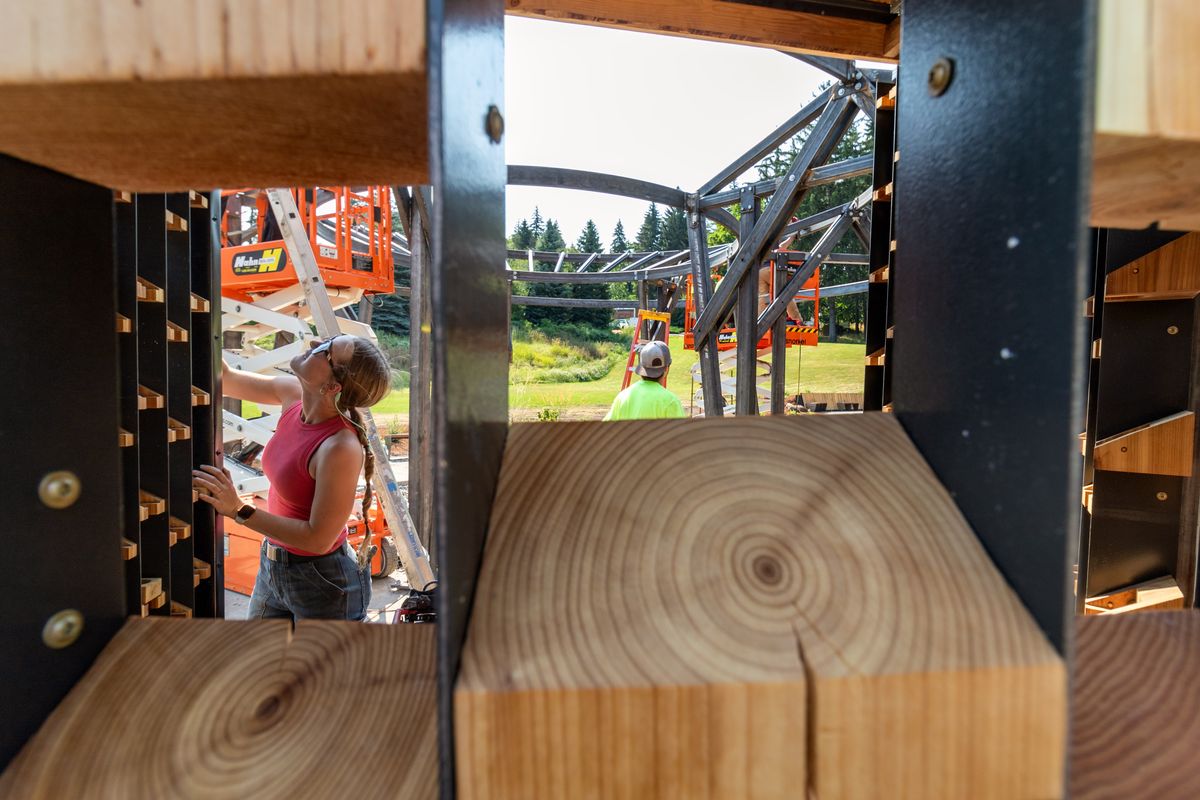The Vandal Healing Garden and Memorial began with grief. The architecture became a journey of hope and togetherness

Grief isn’t linear – and neither is the Vandal Healing Garden and Memorial.
The shape of the garden at the University of Idaho campus swirls in a circle, with planted flowers lining the sidewalks. Crescents of wooden blocks stand high for loved ones to place notes inside to people who have died. Steel beams rise off the ground and surround a spot that will eventually be a memorial sculpture.
A beacon on a nearby hill will be fit with panels and lights to shine across campus, a representation of hope in dark times, said graduate student Harper Drake.
She’s worked around the clock in sweltering summer heat with 18 other University of Idaho architecture students to put the final touches on a place that will memorialize not only all the Vandal students who have died before graduation in years past, but also Ethan Chapin, Kaylee Goncalves, Madison Mogen and Xana Kernodle, who were killed in 2022 in an off-campus home.
“All of us have gone through our own personal journey as we’ve worked on this project. … Like how people approach grief, to how you approach architecture that is focused around grief,” Drake said. “But I think at the end of the day, the thing that is most important to us is just that it’s what the community of Moscow needs.”
When Associate Professor of Architecture Scott Lawrence came to his students at the beginning of last year and began discussing the ideas for the project, they were still reeling from the November homicides.
The conversation was more than emotional, architecture student Korbyn Averett said – but everyone was open to working as hard as they could to get it done.
“We started the research side of it,” he said. “We asked, ‘What is a healing garden?’ And then we asked ourselves, ‘What is healing?’ ”
The students spent 12-hour days collecting feedback from the community about what the garden should look like, and even more hours designing it. They got credit for the class at the time, Averett said, but the project is so much more than that – it was about moving forward together and being a part of something that gave back.
The students have worked this summer to build the structure without pay and without another class credit. That doesn’t matter, Averett said.
“We need to see it through,” he said. “It needs to be done for the community.”
Just two months ago, the garden space was a giant grass field behind the physical education and business buildings on campus. Through thousands of dollars in donations from the community, it’s now expected to be finished in two weeks.
“What is a Vandal Healing Garden memorial like?” Lawrence said Friday as he pointed to the area.
Like grief, he added, “it’s certainly not linear.”
But it is going to be a spot for students and Moscow residents to find peace – in the next 20 years, people will still be able to pay their respects to those lost, Lawrence said. Professors will also be able to hold outdoor classes there, students may do yoga, meditate or just sit on a nearby bench because they need a break between classes.
The students interviewed some families and friends of Chapin, Kernodle, Mogen and Goncalves in order to build the sculpture that will be located in the middle of the garden. The team wanted to portray their memory accurately, Lawrence said – so multiple steel panels in the sculpture will rise from the ground, but four of them will be a different color. When light hits the panels, each will illuminate their four names that will be engraved in the memorial.
The three crescents, which hold over 1,000 wooden blocks that took three weeks to make, will have tubes for people to roll up a note and stick inside.
The school’s archives department will collect the notes once the boxes are full and keep them in a special area so they’re not thrown away.
The tubes will also be lit with tea lights to shine throughout the night.
“They’ll glow kind of like a candle ritual, as we’ve been doing on campus already,” Averett said. “They’re beautiful things. It’s for all Vandals. All Vandals need a space to heal.”
University of Idaho Dean of Students Blaine Eckles said the garden is almost completely built by students, for students. The school wanted the students to have input on what healing meant for their campus, he said.
“They’ve done an amazing job. They’ve surpassed all my wildest dreams, quite frankly,” Eckles said. “They’re phenomenal, and it’s absolutely phenomenal.”
Since the start, the student workers have dealt with their own emotional journey. The homicides in 2022 “completely shifted” the way students thought about the Vandal family, Drake said. It brought a sense of togetherness and hope after tragedy, and the work she’s put in to the structure has helped her process her own feelings from the past two years.
“We’ve all carried that with us the entire time,” Drake said. “No matter how hard the days were, we all know that it’s going to be such an important place on our campus. Vandals are going to need it for so many years to come.”